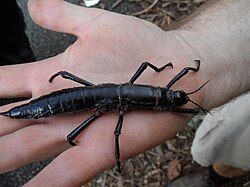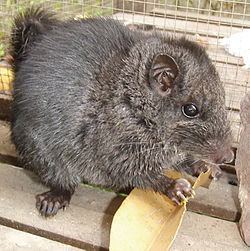Flow diagram illustrating the structure of the IUCN categories of conservation status After IUCN 2017
Attribution:
Das Bild ist mit 'Attribution Required' markiert, aber es wurden keine Informationen über die Attribution bereitgestellt. Vermutlich wurde bei Verwendung des MediaWiki-Templates für die CC-BY Lizenzen der Parameter für die Attribution weggelassen. Autoren und Urheber finden für die korrekte Verwendung der Templates hier ein Beispiel.
Größe:
1772 x 698 Pixel (198015 Bytes)
Beschreibung:
Original description, according to the source, p. 272: "Figure 8.7 Flow diagram illustrating the structure of the IUCN categories of conservation status. An evaluated species can be considered at lower risk of extinction, at high risk of extinction (i.e. threatened), or extinct. A species for which not enough data are available for evaluation is considered Data Deficient (DD). After IUCN, 2017, CC BY 4.0." Context in the source, page 271f: "An important task for conservation biologists is to identify and prioritise those species in greatest danger of extinction. Accomplishing this task requires biologists to collect and review all the information we have on each species. To facilitate this major undertaking, the IUCN has formalised the evaluation and reporting of threatened species assessments using an internationally accepted standard of conservation categories to reflect a taxon’s risk of extinction. These nine categories (Figure 8.7), known as Red List Assessments (IUCN, 2017), are: Extinct (EX). These species are no longer known to exist. As of mid-2019, the IUCN has listed 84 Sub-Saharan African species as Extinct. Extinct in the Wild (EW). These species exist only in cultivation, in captivity, or other human-managed situations. As of mid-2019, the IUCN has listed nine Sub-Saharan African species as Extinct in the Wild. Critically Endangered (CR). These species have an extremely high risk of going extinct in the wild. As of mid-2019, the IUCN has listed 880 Sub-Saharan African species as Critically Endangered. Also included in this category are the 202 Sub-Saharan African species that the IUCN considered possibly Extinct. Endangered (EN). These species have a very high risk of extinction in the wild. As of mid-2019, the IUCN has listed 1,600 Sub-Saharan African species as Endangered. Vulnerable (VU). These species have a moderately high risk of extinction in the wild. As of mid-2019, the IUCN has listed 2,153 Sub-Saharan African species as Vulnerable. Near Threatened (NT). These species are close to qualifying for a threatened category but are not currently considered threatened. As of mid-2019, the IUCN has listed 1,034 Sub-Saharan African species as Near Threatened. Data Deficient (DD). Inadequate information exists to determine the risk of extinction for these species. As of mid-2019, the IUCN has listed 2,441 Sub-Saharan African species as Data Deficient. Least Concern (LC). These species are not considered Near Threatened or threatened. (Widespread and abundant species are included in this category.) As of mid-2019, the IUCN has listed 11,776 Sub-Saharan African species as Least Concern. Not Evaluated (NE). Species that have not yet been evaluated. Most species fall in this category."
Kommentar zur Lizenz:
- Dieses Werk darf von dir
- verbreitet werden – vervielfältigt, verbreitet und öffentlich zugänglich gemacht werden
- neu zusammengestellt werden – abgewandelt und bearbeitet werden
- Zu den folgenden Bedingungen:
- Namensnennung – Du musst angemessene Urheber- und Rechteangaben machen, einen Link zur Lizenz beifügen und angeben, ob Änderungen vorgenommen wurden. Diese Angaben dürfen in jeder angemessenen Art und Weise gemacht werden, allerdings nicht so, dass der Eindruck entsteht, der Lizenzgeber unterstütze gerade dich oder deine Nutzung besonders.
https://creativecommons.org/licenses/by/4.0CC BY 4.0 Creative Commons Attribution 4.0 truetrue
Credit:
John W. Wilson, Richard B. Primack: "Conservation Biology in Sub-Saharan Africa", Chapter 8: "Extinction Is Forever", Open Book Publishers, Cambridge, UK, 2019, ISBN: 978-1-78374-751-1, pp. 257–296, here p. 272, Figure 8.7, DOI:
https://doi.org/10.11647/OBP.0177, License: Creative Commons Attribution 4.0 International license (CC BY 4.0). Original URL of the image:
https://books.openbookpublishers.com/10.11647/obp.0177/image/Fig_8.7.png
Weitere Informationen zur Lizenz des Bildes finden Sie hier. Letzte Aktualisierung: Wed, 10 Jan 2024 06:39:09 GMT
Relevante Bilder
Relevante Artikel
Romeo-Irrtum (Naturschutzbiologie)
Als Romeo-Irrtum oder Romeo-und-Julia-Effekt ist in der Naturschutzbiologie das Phänomen bekannt, dass eine verfrüht erfolgte Aufgabe einer biologischen Art zum Außerkraftsetzen der Schutzbemühungen für diese Art und infolgedessen erst zu ihrer tatsächlichen Ausrottung führen kann.
.. weiterlesen
Lazarus-Effekt
Unter dem Lazarus-Effekt versteht man in der Paläontologie das vorübergehende Nichterscheinen von Taxa im Fossilbericht, häufig mit Bezug auf die Zeit von Massenaussterben. In der Naturschutzbiologie bezieht sich der Ausdruck auf die Wiederauffindung von Taxa, die bereits als ausgestorben gelistet worden waren, also auf ihre Entfernung von der Liste ausgestorbener Arten.
.. weiterlesen










































